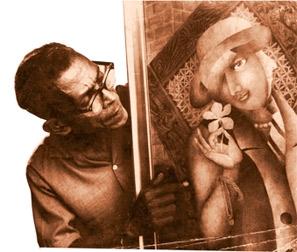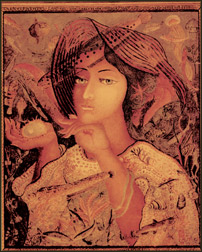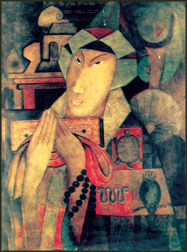|
27th Death anniversary:
Manjusri leaves rich legacy of art
by Indeewara THILAKARATHNE and Ranga CHANDRARATHNE
  Born in Alutgama 1902, LTP Manjusri's remarkable life is marked for
its ups and downs and his immense scholastic brilliance. Having entered
the Buddhist monastic order in 1915, Manjusri earned a name as a scholar
in Sinhala, Pali and Buddhist philosophy. In 1932 he went to
Shantiniketan to study Chinese and came under the influence of Nandala
Bose. This resulted in turning his interest to art. Born in Alutgama 1902, LTP Manjusri's remarkable life is marked for
its ups and downs and his immense scholastic brilliance. Having entered
the Buddhist monastic order in 1915, Manjusri earned a name as a scholar
in Sinhala, Pali and Buddhist philosophy. In 1932 he went to
Shantiniketan to study Chinese and came under the influence of Nandala
Bose. This resulted in turning his interest to art.
On return to Sri Lanka, he began copying documented temple paintings
which subsequently became his life-long pursuit. He had the privilege of
studying Buddhist iconography and Tibetan art at Guntok on the Tibetan
border. Although he was a founder member of the famous 43 group, he
departed from its tradition of surrealistic paintings to devise his own
style based on Sri Lankan motifs.
He held his exhibitions of paintings in diverse parts of the globe
including Smithsonian Institution where his works were exhibited in
1979. Manjusri wrote both in Sinhala and English specialising in the
area of ancient and medieval art and temple paintings. Raising public
awareness on the importance of preserving temple paintings was one of
the major contributions made by Manjusri in preserving Sri Lankan art
forms. He extensively researched and documented the temple paintings so
that they could be studied by future scholars.
 It should be mentioned here that LTP Manjusri, apart from being a
brilliant painter, was also a scholar in Sinhala, Pali and Chinese.
Those who closely associated with LTP Manjusri including the critic
Benedict Dodampegama in an article on Manjusri stated that despite
winning numerous accolades including the coveted Magsaysay Award, he
remained a down -to-earth person with a remarkable wit until he breathed
his last. Dodampegama stated that at the later stage of his life, when
he was recognised specially for his contribution in copying and
documenting temple paintings, he really did not care for the honours.
Dodampegama noted this as a noble trait present in great personalities. It should be mentioned here that LTP Manjusri, apart from being a
brilliant painter, was also a scholar in Sinhala, Pali and Chinese.
Those who closely associated with LTP Manjusri including the critic
Benedict Dodampegama in an article on Manjusri stated that despite
winning numerous accolades including the coveted Magsaysay Award, he
remained a down -to-earth person with a remarkable wit until he breathed
his last. Dodampegama stated that at the later stage of his life, when
he was recognised specially for his contribution in copying and
documenting temple paintings, he really did not care for the honours.
Dodampegama noted this as a noble trait present in great personalities.
Over the years he had devised his own style of painting. This is
amply manifested by his paintings. For instance, the painting titled
'Female Figure' shows, among other things, the artist's keen eye for
details. White, green and yellow have been used as principal colours for
the painting. The female figure is thin and in a way it embodies the
traditional motifs of beauty. The yellowish background would invariably
draw the attention to the female figure in the centre of the frame.The
painting of the maiden is quite different from the previous painting.For
this painting, the artist has used highly toned down red and the
backdrop of the picture seems to be under the sea. The artist has
skilfully depicted it by a large number of fishes. In fact, the maiden's
garment resembles a coral reef. Here the artist has dexterously
integrated minutest details under the sea into the painting. The maiden
is depicted as if emerging from the sea bed. On her palm is an oyster
which once again reminds us of the marine life.The painting of a Tibetan
Buddhist monk is also an interesting painting on many accounts. In the
first place, it demonstrates the artist's sheer power of observation and
his ability to pick up symbols of culture such as a rosary hung on the
monk, the Ola leaf book and the cassock. This is an abstract painting.
His style is unique in the sense that he draws out figures.
Manjusri is best remembered for his singular contribution to art and
especially preserving temple paintings for posterity.His daughter
Manjista Manjusri and son Kusan Manjusri are not only preserving the
proud tradition of their legendary father but also they are artists on
their own right. They are as talented as their celebrated father and
have a thorough grasp of the unique style of LTP Manjusri.
|

